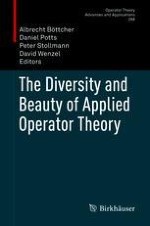This book presents 29 invited articles written by participants of the International Workshop on Operator Theory and its Applications held in Chemnitz in 2017. The contributions include both expository essays and original research papers illustrating the diversity and beauty of insights gained by applying operator theory to concrete problems. The topics range from control theory, frame theory, Toeplitz and singular integral operators, Schrödinger, Dirac, and Kortweg-de Vries operators, Fourier integral operator zeta-functions, C*-algebras and Hilbert C*-modules to questions from harmonic analysis, Monte Carlo integration, Fibonacci Hamiltonians, and many more.
The book offers researchers in operator theory open problems from applications that might stimulate their work and shows those from various applied fields, such as physics, engineering, or numerical mathematics how to use the potential of operator theory to tackle interesting practical problems.
